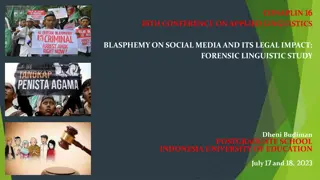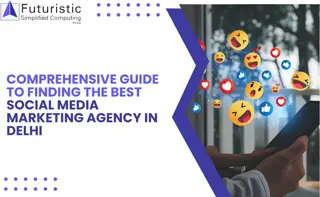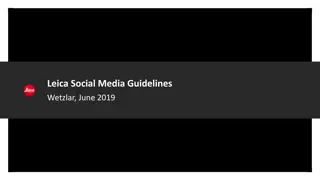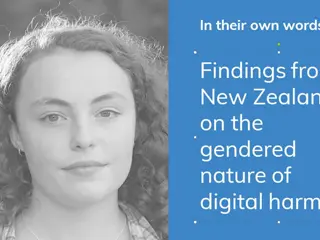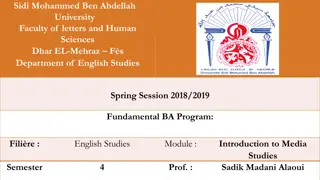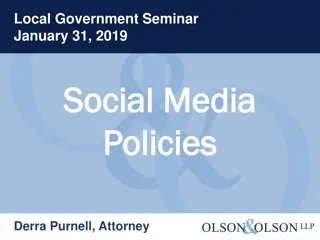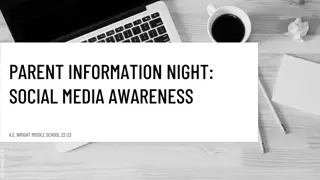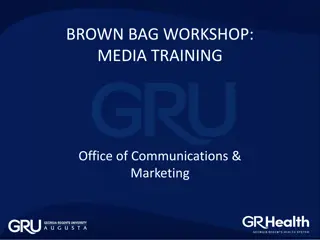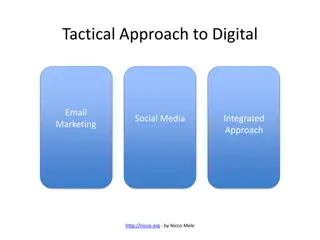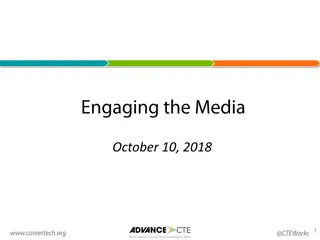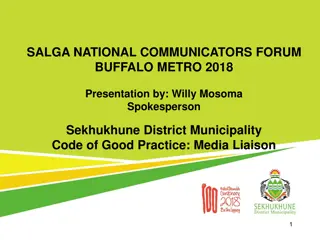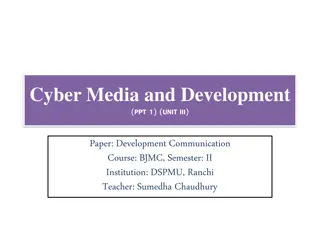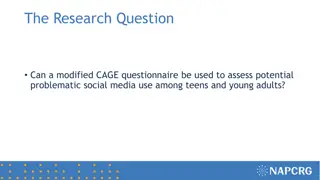Understanding the Impact of Media on Social Behavior
Explore the connection between media and societal behavior, focusing on the effects of exposure to violent content. Various theories and perspectives are discussed, shedding light on how media influences aggression and desensitization in individuals.
Download Presentation

Please find below an Image/Link to download the presentation.
The content on the website is provided AS IS for your information and personal use only. It may not be sold, licensed, or shared on other websites without obtaining consent from the author. Download presentation by click this link. If you encounter any issues during the download, it is possible that the publisher has removed the file from their server.
E N D
Presentation Transcript
Media and violence Most researchers agree that there is an increase in viewer aggression as a result of exposure to violent content Aggressive cues theory S-R learning theory Social cognitive theory Observational learning Information processing theory
Media and violence Questioning majority thinking Catharsis theory Reinforcement theory Additional perspectives Cultivation theory Social construction of reality Desensitization
Aggressive cues theory Formulated by Leonard Berkowitz (1962) Looks at violent content as a stimulus to physiological and emotional arousal, which tends to increase the possibility of aggressive behavior. His classic design was to show subjects excerpts from the movie "The Champion." Subjects in the experimental group were less likely to provide reward and more likely to inflict aggression (electric shock) on a fellow subject.
Beyond generating arousal, pictures of violence, weapons and threats provide cues as to how to release that aggressive energy. The stimulus-response relationship in aggressive cues theory is neither simple nor unconditional. An aggressive stimulus (e.g., a violent television program) does not always elicit an aggressive response, nor will it be likely to elicit the same degree of aggressiveness in all audience members.
One factor that is said to heighten both the likelihood of an aggressive response and increase the degree of aggressiveness of responses is frustration at the time of exposure to a violent television program.
The nature of the violence on television also affects the resultant aggression produced. The prime factor is whether or not the violence was justified. The viewer can learn these patterns of justification to rationalize his own violent actions.
Which is more likely to generate aggressive behavior?
Another important factor is the similarity of the context of the media violence to the frustrations which are produced by the context of the viewer's everyday life. Similarity can be based on many dimensions. Which is more socially dangerous: Rambo: First Blood, or Rambo: First Blood Part Two?
One factor lowers the probability of aggressive actions--the inhibition of aggression. If media portrayals of violence show the pain and anguish of victims of violence, the resultant inhibitions inspired by guilt and sympathy would lead to less violence produced.
Much of the research on the effects of pornography, such as that of Edward Donnerstein and Neil Malamuth, has been conducted under aggressive cues theory. Exposure to pornography has the same effect of enhancing aggressiveness as does exposure to violent content. Responses to violent content are said to differ from individual to individual Selective exposure to violent content Individual differences in inhibition levels
Social Cognitive Theory (Observational learning) Observational learning theory was primarily developed by Bandura based on the belief that aggressive behavior is learned through observation and modeling. Exposure to violent media content is said to increase the probability of aggression not only by providing the audience with an opportunity to learn violent behavior, but also by providing violent behavior models.
Factors that enhance or reduce the effect Attractiveness of the model The more attractive the aggressor, the more likely that he or she will serve as a model for audience members Expectation of reward Physical Social support Similarity of situation in the real world to that in the representation
Information processing theory Huesmann and Eron (1986) identify three psychological processes through which exposing a child to excessive media violence can encourage aggressive behavior: 1) observational learning 2) attitude change: the more TV a child watches, the more accepting the child becomes of aggressive behavior; and 3) scripts: scripts and strategies that have been stored in memory are used as guides for behavior
Another important factor is the similarity of the context of the media violence to the frustrations which are produced by the context of the viewer's everyday life. Similarity can be based on many dimensions. Which is more socially dangerous: Rambo: First Blood, or Rambo: First Blood Part Two?
Reinforcement theory Reinforcement theory is identified with the work of Joseph Klapper (1960). It is based on the assumption that "television portrayals of violence reinforce whatever established pattern of violent behavior that viewers bring with them to the television situation." Media violence, then, does not directly produce or inhibit aggressive behavior.
Propensity for violence is thought to reflect such factors as cultural norms and values, social roles, personality characteristics, and family or peer influences. These factors guide both the "selective" exposure and interpretation of violent media content. The violent content, then, acts merely to reinforce predispositions.
Desensitization Some researchers report that over time, exposure to media violence has a numbing effect on heavy viewers, making them less sensitive to subsequent acts of violence both in the media and in real life. Such a desensitization effect may shrink empathy for suffering in real life and diminish the readiness to go to the help of persons in need. Support for this view comes from Huston et al. (1992) who report on research showing that children and adults who are exposed to televised violence are less likely than unexposed individuals to seek help for victims of violence.
Identified context effects (NTVS) 1) the attractiveness of the perpetrator; 2) the attractiveness of the victim; 3) whether the violence is justified; 4) the presence of weapons; 5) the extent and graphic quality of the violence; 6) the punishment and rewards from the violence; 7) pain/harm cues; and 8) humor.
Major reviews Five principal commissions and review boards have assessed the overall research record regarding media violence: The National Commission on the Causes and Prevention of Violence (1969) The Surgeon General s Scientific Advisory Committee on Television and Social Behavior (1972) The National Institute of Mental Health ( NIMH ) Television and Behavior Project (1982) The Group for the Advancement of Psychiatry Child and Television Drama Review (1982) The American Psychological Association Task Force on Television and Society (1992).
All five reviews note the existence of a significant empirical association between exposure to television violence and aggressive behavior among youthful viewers. Although they each chose different ways of characterizing the relationship, all imply that exposure to violent television programming is more likely than not to increase aggressive behavior among certain parts of the population.
The APA task force concluded: There is clear evidence that television violence can cause aggressive behavior and can cultivate values favoring the use of aggression to resolve conflicts.
Most researchers agree that: Media violence likely explains a relatively small amount of the total variation in youthful violent behavior. Huesmann et al. (1997): What is important for the investigation of the role of media violence is that no one should expect the learning of aggression from exposure to media violence to explain more than a small percentage of the individual variation in aggressive behavior.
A majority of the investigations into the impact of media violence on children find that there is a moderate correlation (approx. r=.30) between exposure to media violence and aggressive behavior.
Researchers also mainly agree that: The media-aggression relationship is a complex one that involves a number of mediating influences. Severe antisocial aggressive behavior appears to occur most often when more than one of these factors is present. The typical profile of a violent youth is one who comes from a troubled home, has poor cognitive skills, and exhibits psychological disorders such as anxiety, depression, and attention deficit hyperactivity.
Social effects v individual effects Social effects relate to either the maintenance or change of social conditions May be good or bad Media may lead to maintenance or change through varied mechanisms
Social effects The most common mechanism thought to operate is for individual exposure to lead to individual attitude/behavior change which accumulates across a large population, generating social change
There can no longer be any doubt that heavy exposure to televised violence is one of the causes of aggressive behavior, crime, and violence in society. The evidence comes from both the laboratory and real-life studies. Television violence affects youngsters of all ages, of both genders, at all socio-economic levels and all levels of intelligence. The effect is not limited to children who are already disposed to being aggressive and is not restricted to this country" (Eron 1992, p. 1).
Shortcomings of individual differences research Static that is, no social adjustment occurs that negates the impact Social structure is ignored Group influences are ignored May enhance or reduce media impact Economics are ignored Supportive or oppositional incentives may be key Ignores context
Changing the level of analysis Individual differences methods may not be appropriate means to test social change theory It is quite possible that while individuals are more aggressive, overall social violence may decrease Violent crime statistics indicated declines during the 1990s while high levels of media violence were found
Changing the level of analysis While individuals may become more aggressive, a number of other things might happen that would lead to overall decline Increase in police Decrease in resistance Increase in resistance (MAD)
Messner Messner collected Nielsen ratings for the heavy violence shows on the NCTV list, which estimated their audience size their popularity in a number of U.S. metropolitan areas. He then looked up F.B.I. crime statistics for those areas for criminal homicide, forcible rape, robbery and aggravated assault. His compared crime rates in the metropolitan areas with the popularity of violent television shows in the same areas.
The results are quite surprising, Messner wrote in his understated conclusion. For each measure of violent crime, the estimate for the level of exposure to television violence is negative.. In other words, [metropolitan areas] in which large audiences are attracted to violent television programming tend to exhibit low rates of violent crime.
Messner offered a simple explanation for his finding: When people are home watching television, they re not out committing violent crimes. And since they re home watching television, burglars can t rob their houses. He even checked his burglary prevention theory. Rates in areas where violent television was popular turned out to be lower not only for burglary but also for auto theft and larceny (simple theft) as well. (Rhodes)
Event studies A major event study analyzed effects on children from the introduction of television in a rural Canadian community during the 1950 s. The researchers in this project compared children before and after the introduction of television in one town (Notel) with their peers in two comparable towns where television was already well established: Unitel (receiving the government-owned channel, CBC) and Multitel (receiving both CBC and U.S. stations).
Findings The level of aggression and poor behavior among children in Unitel and Multitel increased over the period while those in Notel did not.
Ledingham et al. (1993) note that Unitel received only the public television channel (CBC), yet its children exhibited aggression levels similar to the Multitel community, which received U.S. channels (and their greater level of media violence) as well.
[T]he amount of television watched at the initial time of testing by the children of Unitel and Multitel did not significantly predict the amount of aggression seen two years later (although aggression assessed in the follow up period was predicted by television viewing assessed at the same time).
The Atlantic island of St Helena did not exhibit an increase in aggression among children a few years after gaining access to television, possibly because they live in close-knit, carefully supervised communities.
Historical trends If all the assault victims with major injuries had also died improbable even with 1930 s medicine the 1998 U.S. murder rate would only have been double what it was that is, would have been about 13 per 100,000 population rather than 6.3. But even 13 is well below the 23 per 100,000 murder rate of 13th-century England, the 45 per 100,000 of 15th-century Sweden, the 47 per 100,000 of 15th-century Amsterdam. We don t live in the most violent era in peacetime human history ; we live in one of the least violent eras in peacetime human history. (Rhodes)
Video games A number of scholars argue that the structure of video games (especially FPS s) enhances the impact of violent portrayals on real-world aggression. Anderson
The player takes the role of the aggressor and is rewarded for success in killing, etc. The killing is justified The opponent is negatively portrayed Pain and suffering are limited
Additional theoretical approaches Diffusion of innovations Prosocial effects Knowledge gap Agenda setting Spiral of silence



